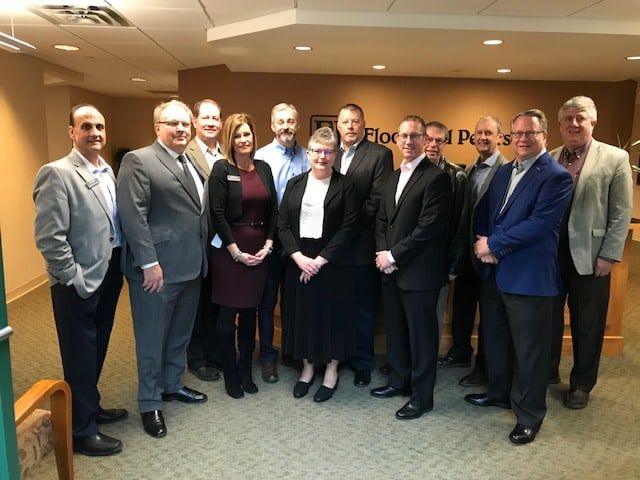Geography affects hiring, financing of life-science companies

FORT COLLINS — Issues affecting life-science companies — particularly staffing shortages and availability of capital — may have as much to do with geography as anything else.
The mountain region, as seen by the centers of life-science activity in the country, is often overlooked as attention is focused on the coasts.
That affects the ability of companies to recruit qualified workers as well as to find investors for startups.
SPONSORED CONTENT
That was the message delivered Wednesday by the CEOs and executives of multiple companies that operate within the life science space in Northern Colorado when they gathered with BizWest to discuss their industry as part of a CEO Roundtable.
Finding workers
“Every researcher we get is from the coasts,” said Mike Duncan, CEO of Tolmar Pharmaceuticals Inc., the largest company at the table with 727 employees. “Some won’t move here. In New Jersey [where Duncan once lived] there are 190 commercial pharma companies. People say that if something [the job] doesn’t work out, they can go down the street to another company. That’s not the case here.”
In fact, Tolmar, which produces Eligard — a drug to treat advanced prostate cancer — along with other pharmaceuticals, has found that people won’t drive 45 minutes from another market to work in Northern Colorado and, if they do, they’ll leave within a year.
The closing of Sandoz in Broomfield, which had more than 1,000 workers, might be seen as a boon for hiring by life-science companies, except the workers don’t want to move and instead wait for jobs with another startup in the Broomfield/Boulder market, Duncan said.
Jon Weston, CEO of PhotoPharma Inc., a startup company developing cancer vaccines, said the region has not yet developed a large enough concentration of life-science companies. “We could use two more CUs and CSUs in this area,” he said. PhotoPharma is a CSU spinoff.
Dean Hendrickson, principal of SurgiReal, another CSU spinoff that develops tools to improve surgical skills of veterinarians, said his small company interviews 10 applicants in order to find one who will fit with the organization. “We’re trying to find better ways to create ladders [for people to advance] but in a small company, there’s not a lot of ways to do that.” SurgiReal has fewer than 10 employees.
Julie Firebaugh, vice president of finance for St. Renatus, a startup that is developing anesthesia therapies, said that in small companies, there isn’t enough room for specialization; employees need to be flexible and willing to work on multiple projects. Finding people to fit that requirement can be challenging.
Clifford Hendrick’s company, Cetya Therapeutics Inc., struggles to find enough money to pay the researchers he needs. Developing pharmaceuticals takes a long time, and until revenue starts flowing, he has to rely on investors and grants in order to keep the research going. He’s had to use researchers from other countries and other areas where grants or tax benefits may be more advantageous.
Housing can also be an issue for people who have bought a home elsewhere and find that appreciated values in Northern Colorado are high, Duncan said.
Lifestyle can be a positive factor in searching for employees. If someone wants to work 80 hours a week, they can do that on the coasts and make a lot of money, but if they want to go skiing or biking on Fridays, that can be accomplished here, Weston said.
Leveraging academic resources can also be helpful, said Ray Goodrich, executive director of CSU’s Infectious Disease Research Center. The Research Innovation Center on the CSU Foothills campus, which his department uses, attracts people and companies that need the research tools offered there. They also see trained individuals are coming out of CSU and are ready to work.
Hendrickson, for SurgiReal, speaking to an issue he faces personally, said that, “We’re a bunch of people with an academic mindset. Our world is about giving things [knowledge] away. Many things have commercial application but they aren’t always apparent to us. We’re not prepared to be innovators. My job is to find better ways to do equine surgery, and we need to get people who understand the business side of the operation earlier in the process.”
Goodrich said that CSU has made efforts recently to train scientists with tools needed to operate a company and how to raise external funding.
Duncan said large companies that might have an interest in investing in a startup often don’t understand the science, but they do understand markets.
“If you can get a big company to validate your product, that carries a lot of weight,” he said. To do that, companies need to create the market picture, which does get the attention of the big companies looking for the next product to market.
“Schools can help themselves by working with [business school] graduate programs to help develop market plans,” he said.
Financing companies
Finding corporate investors is one answer to the financing issue facing many startup life-science companies, the group agreed.
Firebaugh said that her company has approached both angel investors and venture capitalists. In St. Renatus’ case, the company has multiple small initial investors who “need to be taken care of,” she said. Venture-capital firms often want a large piece of the action and sometimes a preferred position, which can dilute the position of earlier investors. Startups also don’t have a lot of tangible assets upon which to rely for traditional financing.
Hendrick of Cetya said he’s caught in a Catch 22: “We need to raise $5 to $7 million, which is out of range of most angels, but yet we don’t have enough data yet to attract venture capital. We need money to get data and data to get money.”
Fortunately, grants have come into play to help support the research activities of the company.
Steve Witt, CEO of OptiEnz Sensors, said that National Science Foundation grants have provided about half of his company’s funding. Custom projects for other companies have also helped.
While Duncan’s company is now financed by revenues, when it started “it was all grant money.” And on the flip side, once companies have earnings, they have earnings expectations that can curtail development efforts because investors want a return instead of being willing to invest in R&D.
Weston said a “valley of death” exists between angel financing and venture capital. “We’re working our networks to find super angels,” he said.
Some opportunities may exist with large pharma companies that are looking for new opportunities. Duncan cited the pending shutdown of Sandoz, which lost the benefit of the generic-drug marketplace. The generic-drug industry has declined for 28 or 29 months, he said. Companies that have relied on generics are now looking for the next big opportunity in branded drugs, and one strategy is to have small and startup companies do the research for large companies.
Cetya has benefited from its relationship with CSU, Hendrick said. The university helps with patent costs. “We don’t have money for IP [intellectual-property] costs because we don’t have products to sell,” he said.
What’s cool
Industry professionals remain pumped up about the future of the industry. “What’s cool is that we’re bridging the gap in health care. There are patients today getting better care because of our training models,” said Hendrickson of SurgiReal.
For Weston, “the cool factor are the immunotherapies in cancer treatment. Improvements in outcomes makes it an exciting time.”
Goodrich said the Translational Medicine Institute at CSU is bridging the gap between animal and human science.
Duncan remains excited about Eligard, which is sold in about 90 countries. “It’s a David-and-Goliath story, and we’re winning it,” he said.
Firebaugh’s excitement comes from creating a product that can become the standard of care in the operating room.
And Hendrick at Cetya said that the wow factor for him is the prospect of providing a better life for people. “Sickle cell [anemia] is a horrible disease. Patients have a lifespan of about 45 years. We can make a difference with a focus on where we spend money,” he said.
The BizWest CEO Roundtables are sponsored in Northern Colorado by EKS&H, now part of Plante Moran; Elevations Credit Union; and Flood and Peterson.
FORT COLLINS — Issues affecting life-science companies — particularly staffing shortages and availability of capital — may have as much to do with geography as anything else.
The mountain region, as seen by the centers of life-science activity in the country, is often overlooked as attention is focused on the coasts.
That affects the ability of companies to recruit qualified workers as well as to find investors for startups.
That was the message delivered Wednesday by the CEOs and executives of multiple companies that operate within the life science space in Northern Colorado when they…
THIS ARTICLE IS FOR SUBSCRIBERS ONLY
Continue reading for less than $3 per week!
Get a month of award-winning local business news, trends and insights
Access award-winning content today!




